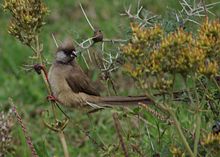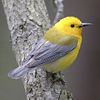Mousebird
| Coliiformes | ||||||||||||||||
|---|---|---|---|---|---|---|---|---|---|---|---|---|---|---|---|---|
 Speckled Mousebird, Colius striatus
|
||||||||||||||||
| Scientific classification | ||||||||||||||||
|
||||||||||||||||
| Genera | ||||||||||||||||
|
Colius |
The mousebirds are a small group of (possibly near passerine) birds which have no real close affinities to other groups, though they and the parrots and cockatoos (Psittaciformes) may be closer to each other than to other birds. The mousebirds are therefore given order status as Coliiformes. This group is confined to sub-Saharan Africa, and is the only bird order confined entirely to that continent. They had a wider range in prehistoric times and apparently evolved in Europe.
Contents |
Description
They are slender greyish or brown birds with soft, hairlike body feathers. They are typically about 10 centimetres in body length, with a long, thin, tail a further 20-24 centimetres in length, and weigh 45-55 grams[1]. They are arboreal and scurry through the leaves like rodents, in search of berries, fruit and buds. This habit, and their legs, gives rise to the group's English name. They are acrobatic, and can feed upside down. All species have strong claws and reversible outer toes. They also have crests and stubby bills.
Mousebirds are gregarious, again reinforcing the analogy with mice, and are found in bands of about twenty in lightly wooded country.
These birds build cup-shaped twig nests in trees, which are lined with grasses. 2-4 eggs are typically laid, hatching to give quite precocious young which soon leave the nest and acquire flight.
Systematics and evolution
The mousebirds could be considered "living fossils" as the 6 species extant today are merely the survivors of a lineage that was massively more diverse in the late Paleogene and Miocene. There are comparatively abundant fossils of Coliiformes, but it has not been easy to assemble a robust phylogeny. The family is documented to exist from the Early Eocene onwards; by the Late Eocene or earlier, two families are known to have existed, the extant Coliidae and the longer-billed prehistorically extinct Sandcoleidae[2]. The latter were previously a separate order[3], but eventually it was realized that they had come to group ancestral Coraciiformes, parrots, the actual sandcoleids and forms like Neanis together in a paraphyletic assemblage. Even though the sandcoleids are now assumed to be monophyletic following the removal of these taxa, many forms cannot be conclusively assigned to one family or the other[4]. The genus Selmes, for example, is probably a coliid, but only distantly related to the modern genera.[5].
Genera
Order COLIIFORMES
- Basal and unassigned forms (all fossil)
- Genus Chascacocolius (Late Paleocene ?- Early Eocene) - basal? sandcoleid?
- Genus Eocolius (London Clay Early Eocene of Walton-on-the-Naze, England) - sandcoleid or coliid
- Genus Selmes (Middle Eocene ?-Late Oligocene of C Europe) - coliid? (synonym of Primocolius?)
- Genus Limnatornis (Early Miocene of Saint-Gérand-le-Puy, France) - coliid? (Urocolius?) Includes "Picus" consobrinus
- "Picus" archiaci (Early Miocene of Saint-Gérand-le-Puy, France) - Limnatornis? coliid? (Urocolius?)
- Genus Necrornis (Middle Miocene of France) - coliid? (Colius?)
- Coliiformes gen. et sp. indet. (Late Miocene of Kohfidisch, Austria)[6]
- Genus Eobucco - sandcoleid?
- Genus Uintornis - sandcoleid?
- Family Coliidae
- Basal and unassigned forms (all fossil)
- Genus Primocolius (Late Eocene/Oligocene of Quercy, France)
- Genus Oligocolius (Early Oligocene of Frauenweiler, Germany)
- Genus Masillacolius (Middle Eocene of Messel, Germany)
- Subfamily Coliinae
- Genus Colius (4 species)
- Subfamily Urocoliinae
- Genus Urocolius (2 species)
- Basal and unassigned forms (all fossil)
- Family Sandcoleidae (all fossil)
- Genus Sandcoleus (Paleocene)
- Genus Anneavis
- Genus Eoglaucidium
Footnotes
- ↑ Cunningham-Van Someren, G.R. (1991). Forshaw, Joseph. ed.. Encyclopaedia of Animals: Birds. London: Merehurst Press. pp. 138-139. ISBN 1-85391-186-0.
- ↑ This is not a typographical error, but a Latinization of Sand Coulee River, where some fossils of Sandcoleus where found. In spoken English, "Coliidae" and "-coleidae" sounds very similar.
- ↑ Houde & Olson (1992)
- ↑ Mayr & Mourer-Chauviré (1999)
- ↑ It has a peculiar foot morphology not found in any other bird, with very stubby toes. The specific name absurdipes ("absurd foot") refers to this. The genus name is an anagram of "Messel", where it was first found.
- ↑ Similar to Urocolius and Limnatornis (if distinct): Mlíkovský (2002)
References
- Houde, Peter & Olson, Storrs L. (1992): A radiation of coly-like birds from the Eocene of North America (Aves: Sandcoleiformes, new order). Natural History Museum of Los Angeles County Science Series 36: 137-160. PDF fulltext
- Mayr, Gerald & Mourer-Chauviré, Cécile (1999): Unusual tarsometatarsus of a mousebird from the Paleogene of France and the relationships of Selmes Peters, 1999. J. Vertebr. Paleontol. 24(2): 366-372. PDF fulltext
- Mlíkovský, Jirí (2002): Cenozoic Birds of the World, Part 1: Europe. Ninox Press, Prague. ISBN 80-901105-3-8 PDF fulltext
External links
- Mousebird videos on the Internet Bird Collection
- Picture of a mousebird atop a tree
|
||||||||||||||||||||||||||
